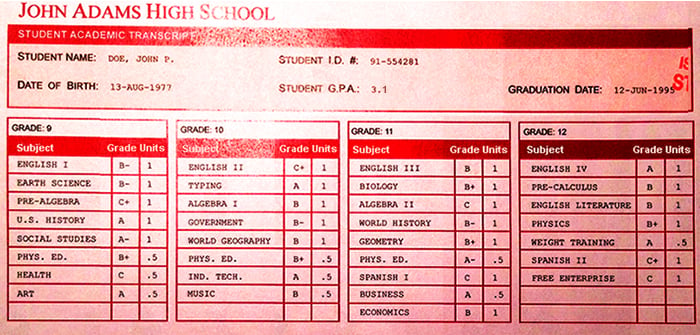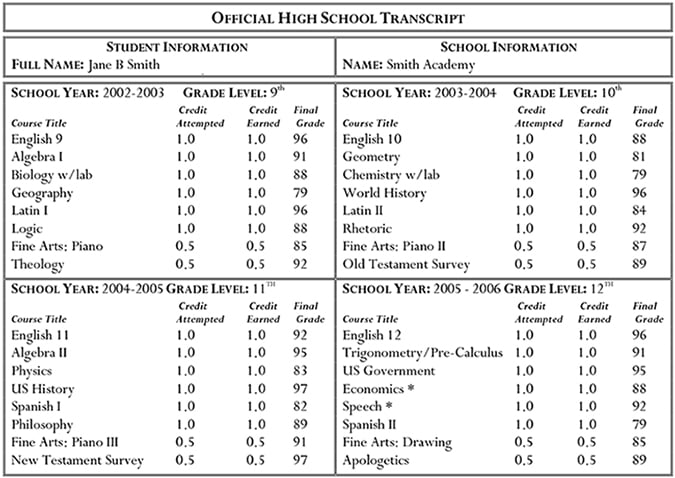
Because final class grades in high school are usually given as either letters (A-, B+, etc.) or percents (87, 92, etc.), you might be a little stuck on how to convert these marks into the decimals that are used to calculate your GPA. No worries—this article is here to help! Keep reading to see how to translate all your grades into GPA-ready numbers.
What Is a GPA?
GPA, or grade point average, is simply the average of all the final class grades you received during your high school career. The GPA scale converts the letter and/or percent grades your school gives you into a decimal, typically ranging from 0.0 to 4.0, and then uses those decimals to calculate a single summary number.
Your GPA is one of the most important pieces of your college application. It allows colleges to very quickly assess your intelligence, skills, work ethic, and willingness to challenge yourself. At the same time, it's an easy way for them to see how you stack up against other people who graduated from your school and all other applicants.
Think about it: for an admissions officer, it's convenient to have one handy number that compares you with other applicants at a glance. It's way harder to have to round up each of your grades and compare them with every grade thousands and thousands of other students have.
 Sisyphus thinks about going through applicants one grade at a time and is all, "Uh, no thanks. I'll stick with the giant boulder."
Sisyphus thinks about going through applicants one grade at a time and is all, "Uh, no thanks. I'll stick with the giant boulder."
How Are Letters and Percents Converted Into a GPA Scale?
Different schools use different systems to convert your grades into your GPA. Sometimes they take the difficulty level of your classes into account, and sometimes all classes are treated the same.
 Sure, they're both pumpkins—but a weighted comparison would be helpful.
Sure, they're both pumpkins—but a weighted comparison would be helpful.
Unweighted GPA Conversion
Most schools use an unweighted GPA. This means that all your final grades get equal treatment, so grades earned in honors, AP, and/or IB courses get the same numerical value as grades earned in standard courses.
In other words, if Matan gets an A in AP Calculus and Camille gets an A in standard-level chemistry, the school will convert both these As into a 4.0.
Here is the typical conversion scale for an unweighted GPA:
| Letter Grade | Percentage | GPA |
| A+ | 97-100 | 4.0 |
| A | 93-96 | 4.0 |
| A- | 90-92 | 3.7 |
| B+ | 87-89 | 3.3 |
| B | 83-86 | 3.0 |
| B- | 80-82 | 2.7 |
| C+ | 77-79 | 2.3 |
| C | 73-76 | 2.0 |
| C- | 70-72 | 1.7 |
| D+ | 67-69 | 1.3 |
| D | 65-66 | 1.0 |
| F | Below 65 | 0.0 |
Weighted GPA Conversion
Some schools calculate a weighted GPA, which does take into account how challenging each course is. So, final class grades in honors-level courses have .5 added to them, whereas final grades in AP and IB courses have 1 added to them. For this reason, weighted GPA scales usually range from 0.0 to 5.0 (though you might also see up to 6.0).
In our example above, since Matan's A came from an AP class, it would convert to 5.0. Meanwhile, Camille's A, which came from a standard-level class, would become 4.0.
The typical weighted GPA conversion scale looks like this:
| Letter Grade | Percentage | Honors GPA | AP/IB GPA |
| A+ | 97-100 | 4.5 | 5.0 |
| A | 93-96 | 4.5 | 5.0 |
| A- | 90-92 | 4.2 | 4.7 |
| B+ | 87-89 | 3.8 | 4.3 |
| B | 83-86 | 3.5 | 4.0 |
| B- | 80-82 | 3.2 | 3.7 |
| C+ | 77-79 | 2.8 | 3.3 |
| C | 73-76 | 2.5 | 3.0 |
| C- | 70-72 | 2.2 | 2.7 |
| D+ | 67-69 | 1.8 | 2.3 |
| D | 65-66 | 1.5 | 2.0 |
| F | Below 65 | 0.0 | 0.0 |
2 Step-by-Step Unweighted GPA Conversion Examples
Let's work through a couple of examples to see how grade conversion works for a transcript that uses letter grades and one that uses percent grades.
Note that in both examples below, we will not be factoring how many credits a class is worth into our GPA conversions; therefore, feel free to ignore the credits/units columns in the images of the transcripts.
#1: How to Convert Letter Grades Into a GPA
First, let's check out a transcript in which final grades are given as letters by taking a look at the high school career of renowned secret operative John Doe:

Here's how its conversion works. Using the unweighted conversion table from before, we can see that, year by year, the grades John earned are as follows:
| 9th Grade | 10th Grade | 11th Grade | 12th Grade |
| 2.7 | 2.3 | 3.0 | 4.0 |
| 2.7 | 4.0 | 3.3 | 3.0 |
| 2.3 | 3.0 | 2.0 | 3.0 |
| 4.0 | 2.7 | 2.7 | 3.3 |
| 3.7 | 3.0 | 3.3 | 4.0 |
| 3.3 | 3.3 | 3.7 | 2.3 |
| 2.0 | 4.0 | 2.0 | 2.0 |
| 4.0 | 3.0 | 4.0 | |
| 3.0 |
Now, to figure out John's GPA, first we have to add up his grades to get the sum. Then, we have to count how many classes he took. Finally, we divide the sum by the number of classes and round to the nearest hundredth:
| 9th Grade | 10th Grade | 11th Grade | 12th Grade | Total | |
| Grade Sum | 28.0 | 25.3 | 27.0 | 21.6 | 101.9 |
| # of Classes | 8 | 8 | 9 | 7 | 32 |
Here's how to calculate John's cumulative GPA:
101.9 / 32 = 3.18 (John's cumulative high school GPA)
To figure out the GPA John would put on his college applications, we just leave off the senior-year grades and repeat the same process:
28 + 25.3 + 27 = 80.3 (sum of final grades from 9th to 11th grade)
8 + 8 + 9 = 25 (number of classes taken from 9th to 11th grade)
80.3 / 25 = 3.21 (GPA sent on college applications)
#2: How to Convert Percents Into a GPA
The process for converting percents into GPA is almost exactly the same. Let's see it in detail by calculating the GPA of John's archrival and spy nemesis, Jane Smith:

First, we'll convert her grades into the GPA scale. Then, we'll find both the sum and the number of classes she took:
| 9th Grade | 10th Grade | 11th Grade | 12th Grade | Total | |
| 4.0 | 3.3 | 3.7 | 4.0 | ||
| 3.7 | 2.7 | 4.0 | 3.7 | ||
| 3.3 | 2.3 | 3.0 | 4.0 | ||
| 2.3 | 4.0 | 4.0 | 3.3 | ||
| 4.0 | 3.0 | 2.7 | 3.7 | ||
| 3.3 | 3.7 | 3.3 | 2.3 | ||
| 3.0 | 3.3 | 3.7 | 3.0 | ||
| 3.7 | 3.3 | 4.0 | 3.3 | ||
| Grade Sum | 27.3 | 25.6 | 28.4 | 27.3 | 108.6 |
| # of Classes | 8 | 8 | 8 | 8 | 32 |
Here's what we get when calculating Jane's GPA:
108.6 / 32 = 3.39 (Jane's cumulative high school GPA)
And by leaving off her senior year, we can find the GPA she'll use for her college applications:
81.3 / 24 = 3.39 (the GPA she will submit to colleges)
What's Next?
Still confused about how weighted and unweighted GPA calculations work? Let us help you figure it all out with our comprehensive explanation.
Worried about how your GPA will measure up? We explain what a good or bad GPA is and run the numbers on the average high school student.
Aiming for a super high or even perfect GPA? Get all the expert tips you'll need in our guide on how to get a 5.0.
Have friends who also need help with test prep? Share this article!

Anna scored in the 99th percentile on her SATs in high school, and went on to major in English at Princeton and to get her doctorate in English Literature at Columbia. She is passionate about improving student access to higher education.



































 Holly R.
Holly R.